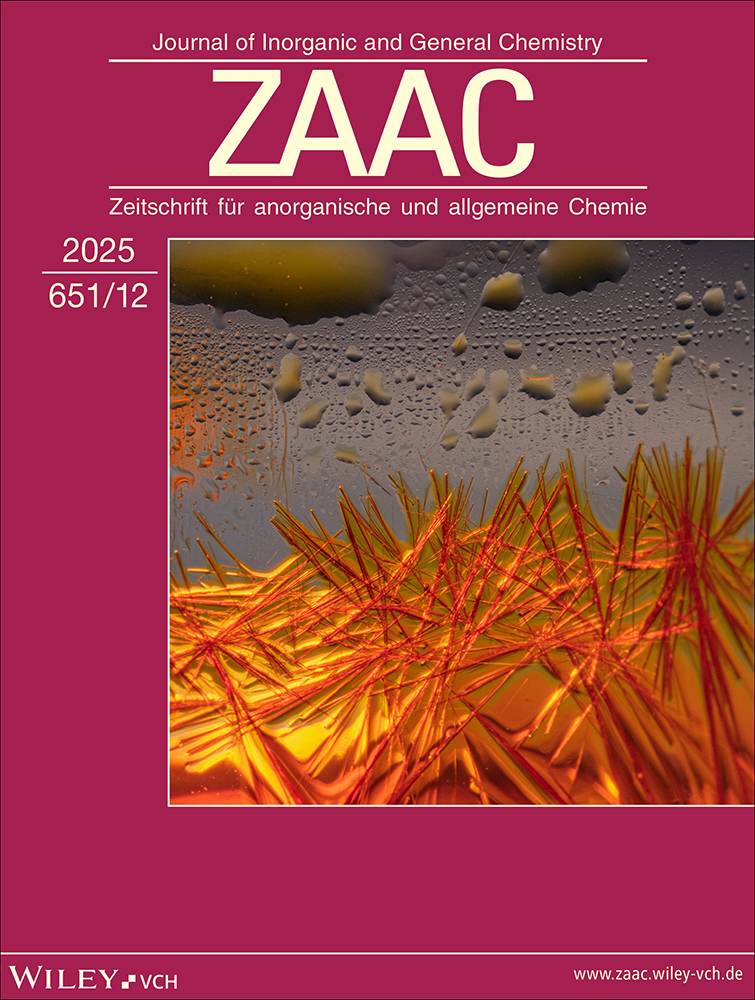Die Kristallstrukturen von (NH4)2[ReCl6], [ReCl2(CH3CN)4]2[ReCl6] · 2CH3CN und [ReCl4(18-Krone-6)]
Abstract
deBraune Einkristalle von (NH4)2[ReCl6] entstehen durch Reaktion von NH4Cl mit ReCl5 in einer Diethylethersuspension. [ReCl2(CH3CN)4]2[ReCl6] · 2CH3CN kristallisiert als braune Kristallplättchen aus einer Lösung von ReCl5 in Acetonitril. Leuchtend grüne Einkristalle von [ReCl4(18-Krone-6)] entstehen durch Reaktion von 18-Krone-6 mit ReCl5 in einer Dichlormethansuspension. Die drei Rhenium-Verbindungen werden durch ihre IR-Spektren und durch Kristallstrukturanalysen charakterisiert.
(NH4)2[ReCl6]: Raumgruppe Fm3m, Z = 4, 75 unabhängige beobachtete Reflexe, R = 0,01. Gitterkonstante bei −70°C: a = 989,0(1) pm. Die Verbindung kristallisiert im (NH4)2[PtCl6]-Typ, der ReCl-Abstand beträgt 235,5(1) pm.
[ReCl2(CH3CN)4]2[ReCl6] · 2CH3CN: Raumgruppe P1, Z = 1, 2459 beobachtete unabhängige Reflexe, R = 0,12. Gitterkonstanten bei −60°C: a = 859,0(1); b = 974,2(7); c = 1287,3(7) pm, α = 102,69(5)°; b̃ = 105,24(7)°; γ = 102,25(8)°. Die Struktur besteht aus zwei symmetrieunabhängigen [ReCl2(CH3CN)4]+-Ionen mit trans-ständigen Chloratomen, [ReCl6]2−-Ionen und eingelagerten Acetonitrilmolekülen. In den Kationen betragen die ReCl-Abstände im Mittel 233 pm, im Anion im Mittel 235 pm.
[ReCl4(18-Krone-6)]: Raumgruppe P21/n, Z = 4, 3 633 beobachtete unabhängige Reflexe, R = 0,06. Gitterkonstanten bei −70°C: a = 1040,2(4); b = 1794,7(5); c = 1090,0(5) pm; b̃ = 108,91(4)°. Die Verbindung bildet eine Molekülstruktur, in der das Rheniumatom oktaedrisch von den vier Chloratomen und von zwei Sauerstoffatomen des Kronenethers koordiniert ist.
Abstract
enThe Crystal Structures of (NH4)2[ReCl6], [ReCl2(CH3CN)4]2[ReCl6] · 2CH3CN and [ReCl4(18)(Crown-6)]
Brown single crystals of (NH4)2[ReCl6] are formed by the reaction of NH4Cl with ReCl5 in a suspension of diethylether. [ReCl2(CH3CN)4]2[ReCl6] · 2CH3CN crystallizes as brown crystal plates from a solution of ReCl5 in acetonitrile. Lustrous green single crystals of [ReCl4(18-crown-6)] are obtained by the reaction of 18-crown-6 with ReCl5 in a dichloromethane suspension. All rhenium compounds are characterized by IR spectroscopy and by crystal structure determinations.
(NH4)2[ReCl6]: Space group Fm3m, Z = 4, 75 observed unique reflections, R = 0.01. Lattice constant at −70°C: a = 989.0(1) pm. The compound crystallizes in the (NH4)2[PtCl6] type, the ReCl distance is 235.5(1) pm.
[ReCl2(CH3CN)4]2[ReCl6] · 2CH3CN: Space group P1, Z = 1, 2459 observed unique reflections, R = 0.12. Lattice dimensions at −60°C: a = 859.0(1), b = 974.2(7), c = 1287.3(7) pm, α = 102.69(5)°, b̃ = 105.24(7)°, γ = 102.25(8)°. The structure consists of two symmetry-independent [ReCl2(CH3CN)4]+ ions with trans chlorine atoms, [ReCl6]2− ions, and included acetonitrile molecules. In the cations the ReCl bond lengths are 233 pm in average, in the anion they are 235 pm in average.
[ReCl4(18-crown-6)]: Space group P21/n, Z = 4, 3 633 observed unique reflections, R = 0.06. Lattice dimensions at −70°C: a = 1040.2(4), b = 1794.7(5), c = 1090.0(5) pm, b̃ = 108.91(4)°. The compound forms a molecular structure, in which the rhenium atom is octahedrally coordinated by the four chlorine atoms and by two oxygen atoms of the crown ether molecule.




